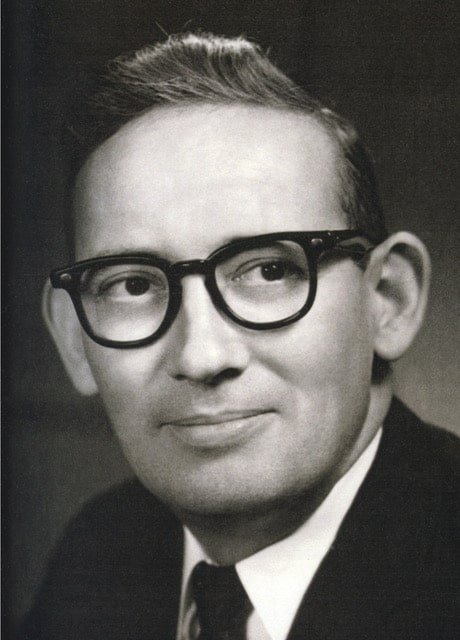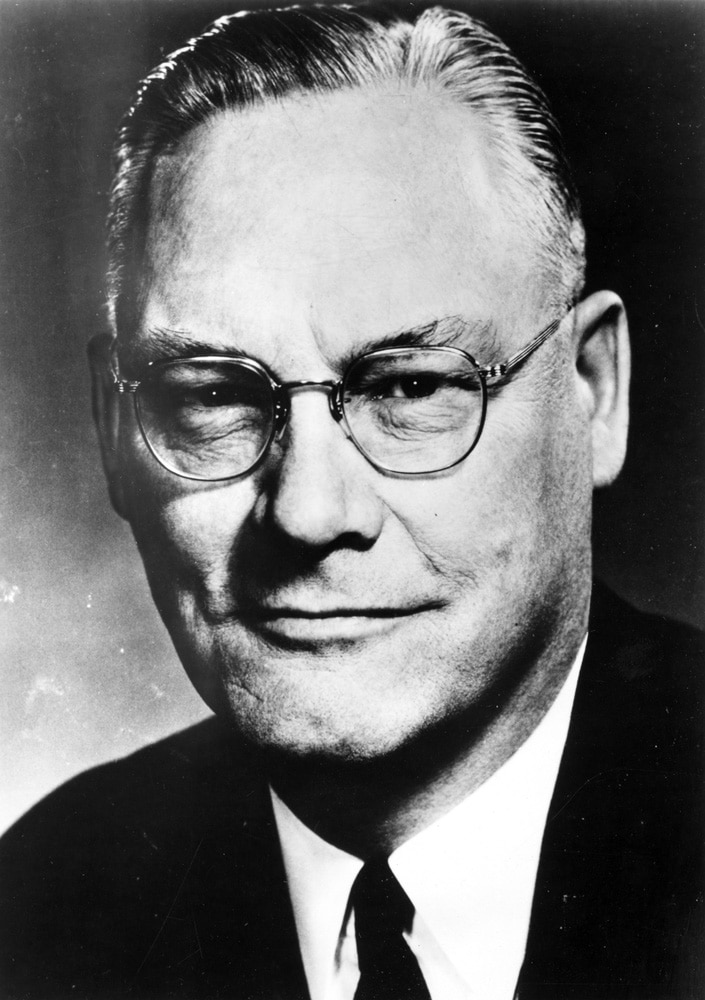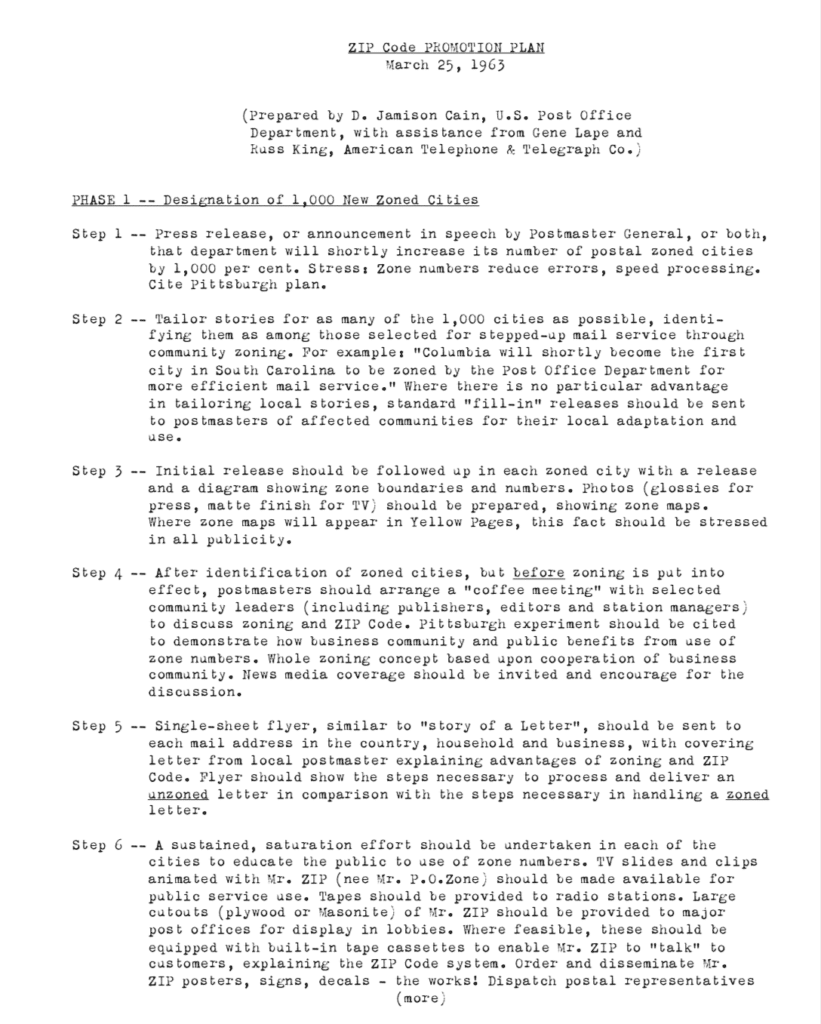The Post Office Era
The rollout of the ZIP Code program was done in a very different (and much more effective way) way than previous campaigns. This was thanks in large part to D. Jamison Cain.
Cain came from Sumter, South Carolina where he worked in South Carolinian politics and newspapers. He came to Washington D.C. to cover Congress and got to know Lyndon B. Johnson personally during his time as Senate Majority Leader. During the implementation of the ZIP Code system he was Deputy Special Assistant for Public Information.
The marketing effort was a joint project between the Post Office and AT&T. The story goes that J. Edward Day (Postmaster General) met Frederick Kappel (Chairman of the Board for AT&T) on a flight from Chicago to Washington D.C.
Day told Kappel that the Post Office was getting ready to launch a massive advertising campaign to promote their new address zoning system. Kappel advised caution and told him of the problems that AT&T faced when they introduced all-digital dialing and area codes.
Day welcomed any assistance. Soon after that flight a group of people from AT&T came to Washington D.C. with a proposal for a mascot based on the illustrations of Howard Wilcox that he created for Chase Manhattan (and AT&T had subsequently acquired).
The delegation from AT&T included Russ King (Head of the Yellow Page division), Gene Lepe (AT&T’s PR person) and Hal Saltsman and they met with James F. Kelleher (Day’s special assistant for public information), Assistant Postmaster General Frederick C. Belan and D. Jamison Cain.
The Post Office didn’t have the money for the ZIP promotional campaign so AT&T gave them $3 million in goods and services. For example, the stickers that you saw on mailboxes in the 60s, the Post Office ordered them and AT&T paid for them. AT&T was more than happy to help as the public was pretty upset with them over area codes and they thought that the Post Office implementing ZIP Codes would take a little bit of the heat off them.
ZIP Code Promotion Plan
The marketing plan was fairly comprehensive and is best described by a April 22, 1963 memo by Cain entitled ZIP Code Promotion Plan.
- A national release to go out simultaneously with Mr. Day’s press conference.
- A fact sheet on ZIP-Code that is up-to-date.
- Q & A sheet on how local zoning fits into ZIP-Code.
- A local fill-in press release on zoning.
- A local fill-in release announcing zone boundaries.
- Zone maps (line drawings as used in ABCD) showing zone numbers and boundaries.
- A local fill-in feature story on what ZIP-code will mean to Ourtown.
- A speech with appropriate local fill-ins to used by postmasters before civic groups.
- A flyer showing steps ZIP-Code eliminates.
- An Instruction sheet for postmasters outlining a suggested promotional plan.
- Life-sized Mr. ZIP reproductions on heavy white paper with instructions telling postmasters how to attach to plyboard and cut where dotted lines are with jigsaw.
- Scripts for spot radio and TV public service announcements (Podunk is zoned for ZIP-Code).
- A parody on Walt Disney’s Zippedodah, adapting it to Mr. ZIP and ZIP-Code.
- Clearance from whoever holds the copyright on Zippedodah to utilize the melody in our promotional campaign.
- Tapes of Mr. ZIP singing the song.
- TV slides and clips with animated Mr. ZIP to be made available for public service use.
- Plywood cutouts of life-sized Mr. ZIP, equipped with tape transmitter explaining ZIP-Code zoning.
- Zip truck poster for national use, to be substituted on all mail vehicles for the currently used “Address your Mail Carefully” standard truck poster.
- Adaptation of AT&T slides to ZIP-Code promotion plan, with new script and some new slide shots.
- Suggested layouts for local reproduction of lobby posters, signs, tent cards, bulletin board notices.
- Postage meter slugs and special cancellation dies stressing ZIP-Codes zoning.
- Memorandum from Mr. Day to all postmasters in the newly zoned cities stressing urgency of a massive promotional campaign within the little time that remains between now and July 1.
- ZIP-Code news kit envelopes of sufficient size and capacity to hold most of the foregoing and with an appropriate Mr. ZIP symbol on the cover. The cover should also have the Post Office Department’s ZIP-Code number rather than the Zone 25 in the return address.
- Newspaper mats of Mr. ZIP.
- Local truck posters to be used in 208 cities with gummed label for localization, to be used in connection with the zoning for ZIP-Code program.
- Mr. ZIP decals for every mail truck in the country.
- Stencils for decals for every carrier’s mail pouch in the country.
- Copy for 5 x 7-inch two-color cards to be delivered to every mailbox holder in the country.
- Copy for one-column by 3-inch ads to be placed in all major magazines in the country (the top 20 or 25).
- 5 x 7-inch decals of Mr. ZIP and appropriate ZIP-Code slogan, two to be placed on each mailbox in the country.
- A good, catchy solid slogan, brief but comprehensive, to be hammered home as the central message in all of our promotional efforts.
- Maps of the U. S. showing ZIP-Code areas and sectional center boundaries.
- Have an optical banner installed in the Postmaster General’s Reception Room.
- Maps of each ZIP-Code area in the country showing sectional center boundaries.
- Slides to be used by Day in his presentation next week.
- Notices to be sent out well in advance of the press conference notifying the press of the time and place.
- Rear-screen projector to be used during the Mr. Day’s presentation.
How Mr. ZIP got his name
The Post Office decided to kick off the new postal code system in Pittsburgh as they already had experience with postal codes during the war as they were a two-digit zone.
Back in 1943 during WWII some cities instituted two digit postal zones. This was because many of the experienced postal clerks had gone to war and the newer inexperienced workers were having trouble sorting the mail. With this system a two digit number comes after the city to assist the clerks in sorting.
Cain said “Okay, so what we’re doing here is, we’re improving on that two-digit zone”. So I said, “We’ll call this ‘Zoning Improvement Plan’, and we’ll shorten it to ‘ZIP Code: Zoning Improvement Plan Code”.
After they decided on the name for the new numbering system, Mr. P.O. Zone came up, and Cain said, ‘No, that’s awful’ and suggested they change the name to Mr. ZIP.




